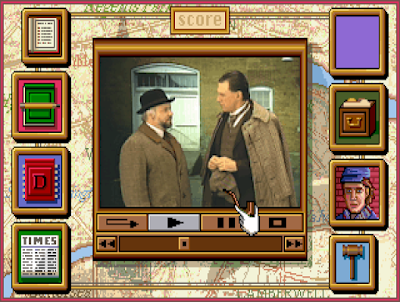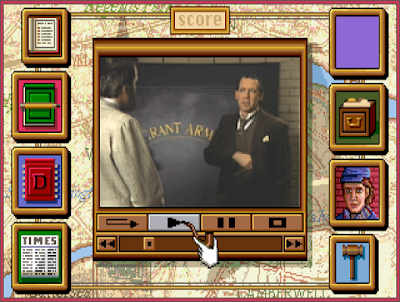From The Adventure Gamer
Written by Joe Pranevich
The time has come to put another game into the cabinet and officially close out 1992! We played a staggering 38 adventure games this year. I’ll leave the year-end commentary to Ilmari, but we are moving on quickly to 1993 which somehow has even more games. It’s an exciting era in video game history and I am thrilled that we are able to document so much of it.
Before we move onto the final rating, I have one last piece of business: the “unauthorized strategy guide” for this game. I purchased it while I was stuck on the second case but did not end up using it. Long time readers may know that I have an interest in old strategy guides and this one was quite a find! Not only is it surprisingly detailed, it was also written by one of the industry’s great game designers: Bruce C. Shelley. We haven’t seen Shelley in our corner of the gaming world (in fact, he has only one adventure game credit to his name, a 1993 children’s adventure which didn’t make the cut), but he was a former Avalon Hill nut who became Sid Meyer’s “assistant” and later co-designer on a number of games. Civilization, Railroad Tycoon, Covert Action, Age of Empires, and their spin-offs and sequels would not be the way that they are today without Shelley’s influence. That makes this hint book one of the best pedigreed in the industry. Let’s get to it!
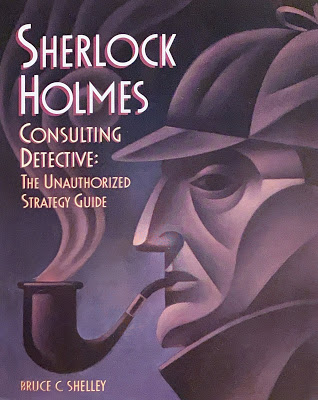 |
| Nothing beats a deerstalker and pipe. |
Although I have collected a number of hint books over the years, there are a few things that I do not understand yet and that I should research further. There was a period in the early 90s when “unauthorized” strategy guides were all the rage. This was fueled in part by newcomers Prima Games (founded in 1990) and Brady Games (1993), but there were plenty of other publishers searching for a cut of the video game market. Someday, I may compile the most boring ever history of hint books and game guides, but I doubt anyone would read it. This particular guide is from Prima’s “Secrets of the Game” series, but it doesn’t advertise itself as such on the cover. One feature that a number of these “unauthorized” guides had in common was a fictionalized retelling of the story of the games. I’ve seen that in Sierra guides and the same is true here. These guides alternated story bits (that would reveal answers to puzzles narratively) with more straight up strategy notes. Did they do that to provide legal cover? Was it “fair use” to produce unauthorized guides this way? I have absolutely no idea.
Shelley clearly poured his heart into the research for this guide. He even went to the tabletop version to flesh out details for his narrative and to point out where the computer game missed a plot point in the conversion. In the forgery case for example, he reveals that the floorplan for the National Gallery was a much larger part of the mystery. Players had to use it to understand and map out how the thief made it from the crates to the gallery and then out, but these details were not included in our version of the game. And while the guide was “unauthorized”, Shelley was able to get the original scripts from Viacom for all three games so that he could document the dialog as the developers intended. Thanks to his research and his own love of the Holmes mysteries, the “fictionalized” retellings are perhaps some of the best in the hint book industry.
Shelley also plays the game differently than I did, but you may want to try it his way: After solving the case the first time, Shelley recommends working out the exact clues that Holmes used in order to get his score. He sees it as a logic problem to identify the minimum number of witnesses needed, whether you have to go yourself or send one of the Irregulars, etc. He tracks his score closely after each witness and worked out that (usually) you can tell the value of a witness by now many points you scored. Each key witness increments the score by seven, while relevant-but-unnecessary witnesses increase it by ten. Following a red herring nets you an amazing twenty points. Keep in mind of course that the goal is to have as few points as possible! This isn’t the way I would like to play the game, but if you are looking to wring a few more hours of play time out of the game, that may be something to try.
 |
| Bruce Shelley in the late 90s or early 2000s. |
Shelley divided each of the nine included cases into three sections:
- Holmes’s Story – The fictionalized version of the case.
- The Evidence – A description of the relevant evidence, including each newspaper article and the witnesses that is required for judgement. The witness sections are lightly narrated.
- The Solution – The annotated solution and why I fell in love with this guide. Shelley goes through Holmes’s solution, usually proving that he couldn’t actually have solved it the way that he claimed. This may be because he skipped clues that he would have needed or had information in the epilogue that he never learned.
The “Solution” section also includes bugs and issues that he discovered with the case, beyond simply Holmes cheating to get the best possible score. He found:
- Case #1 – The game is inconsistent whether Barry O’Neill broke one leg or two, with the video showing only one. One of the newspaper articles is mid-dated (in July instead of March) so that you miss learning about one of Thomas O’Neill’s criminal misadventures.
- Case #2 – The whole case is, as I suspected, misdated. The newspaper should have been January 22, plus it has an auction announcement on June 9 that should not have been there. Although the solution requires you to know how the thieves left the gallery, the game never tells you. Other details such as the museum layout were omitted completely.
- Case #3 – This case was mostly bug-free but the game excised two newspaper articles, although neither are absolutely required. This was probably because they were misdated in the tabletop version as well.
Shelley’s reason for writing this guide is perhaps not surprising. Although he was a huge success in Microprose initially, he left in 1992. For the next two years, he seems to have bounced around before settling into Ensemble Studios where he would eventually design Age of Empires. Those two years were filled by writing at least six guidebooks and one children’s adventure game (Peter Pan: A Story Painting Adventure). Even after moving to Ensemble, he continued to write the occasional guidebook, including one for his own Age of Empires II. There is a great story here waiting to be told and I hope someday we will be able to research and tell it in full.
With my diversion out of the way, let’s jump into the final rating!
 |
| Order in the court! |
Final Rating
I have been torn over how this game would come out. I thought at first that it would score the same as its predecessor: it was the same engine, developed by the same people, using stories from the same source. Given the bugs this time around, I no longer think that is the case. While the previous game had something to prove (and sold more than 250k copies as a result), this game seemed to have been developed with a somewhat less expensive attitude. We’re just have to see how that impacts each of our scoring categories.
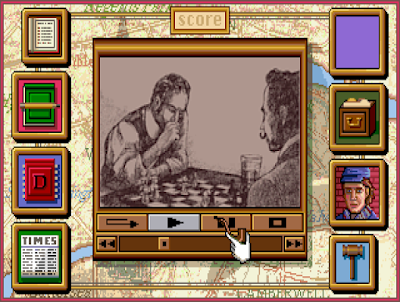 |
| You sunk my battleship! |
Puzzles and Solvability
This game and its predecessor are not traditional adventure games. I questioned last time whether we should be covering them at all, but ultimately decided that they counted because of their innovative premise and the way they pushed on the status quo. Without inventory puzzles, we are ultimately left with only the cases themselves and the way they are presented.
The game is stateful, but only in the sense that you have to trigger each of the required scenes before you can access the judging area. This makes the endgame for each case a bit less exciting, although I had not considered this aspect before. Maybe you personally didn’t piece together the evidence correctly, but if you can go into the judging then you must have all of the required info. If you only follow red herrings, you cannot even get in so it does narrow the scope of the ending quite a bit. This game also felt like it leaned on multiple choice questions more than the previous one, but that may be just my shoddy memory. I admit that more than once I had to deduce from the choices rather than working out the answers myself just from the witness testimony. If you don’t care about your score, all you need to do is do the judging over and over again until you pick the right option.
The three cases in this game were solid overall. Unlike the first game where I doubted the plausibility of hynotism as a murder weapon, all of the cases were within the realm of possibility. I had fun! The second case was the weakest link when it came both to complexity and bugs, but it wasn’t so bad.
My score: 5.
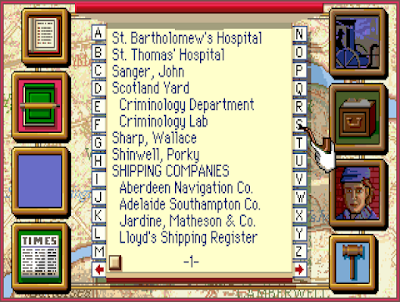 |
| The directory can still be painful to search. |
Interface and Inventory
Usually, when judging “Interface and Inventory”, we have a variety of similar games to compare against. Is it a text adventure? Point-and-click? A hybrid? With this series, ICOM crafted something unique, an interface that both adapted the tabletop game roots of the series while also being pretty darned effective as a simple multimedia menu system. The problem is that they added absolutely nothing this time around except for judging videos.
I ended up using the in-game newspaper this time around, thanks to the lack of online documentation and my inability to purchase a copy that actually contained the manual. (I bought two! Both lied!) The found the in-game interface to be serviceable, although reading that much text in low resolution will never be fun. I did not deduct any points for this because a real player in 1992 wouldn’t have had difficulty with the manual. The directory interface continues to be confusing with its odd mismash of category headings and direct alphabetization. As in the example above, “Aberdeen Navigation” appears under “S!” Add that to my spelling difficulties and the directory became a weak link in my enjoyment of the game.
My score: 4.
 |
| A dinner party during a robbery! How chic. |
Story and Setting
Individually, each of the cases in this set had something interesting on offer: the first had an interesting view of circus life and the tragic deaths of two trained lions, the second had a fantastic forgery puzzle where we came to learn that there were no real paintings at all, and the third offered a “spy thriller” as we witnessed the scheming of multiple European powers over a British military weapon. In these cases, this era of London is well-depicted, even as we have very few scenes that are more than the interior of yet another sitting room. For a group of midwestern actors on a shoestring budget, they did well… but some exterior shots and maybe an actual trip to London would have gone a long way.
Although I forgave it last time, I am less inclined to forgive that the cases are not connected at all. They build to nothing. We are playing the stories out of chronological order, so there can be no character or plot development. The single reference to a previous case that I found was to the “Society Burglar” of the previous game, but even that was just intended as a red herring if you didn’t recall that you followed those clues once already. Holmes fans will point out that there are nearly no connections between his original cases either, but at least Doyle gradually shows us Holmes and Watson growing and changing over their careers. All we have is out of order cases.
My Score: 4
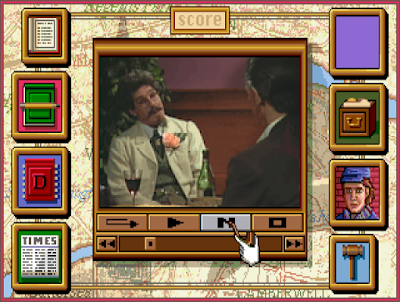 |
| The corsage budget alone was millions. |
Sound and Graphics
While the previous game was revolutionary in its extensive use of video, this game only pushes the envelope in a few small ways. The new judging scenes are great, replacing a static drawing of a judge used in the previous cases. (I believe that re-releases of the first game included fully recorded judging, but the edition I played did not.) The cinematographer better lit the scenes this time around so we could see more of the details; I expect that he or she did not realize the limitations of low-resolution graphics as clearly in the first game. Improving the picture quality had the drawback that the green screen effects are much more obvious this time around.
I mostly ignored the sound, but there were some nice touches including background music in many of the scenes and striking musical cues when a critical clue was discovered. It’s not high art but I appreciated it.
My score: 6.
Environment and Atmosphere
I wish I could say that Victorian England comes alive in this game, but with so many scenes in nearly identical offices and sitting rooms, it is difficult to get a feel for the place. The occasional sepia-toned illustration helps, but this game needed a larger filming budget. Accents were often thick and exaggerated, except for the handful of main actors. There are a handful of moments that transcend what they were limited with, but overall I felt less invested in this world than I did the first game. That investment is the best way for me to measure the intangible “atmosphere” component of the game. It wasn’t bad at all, but far from perfect.
My score: 5.
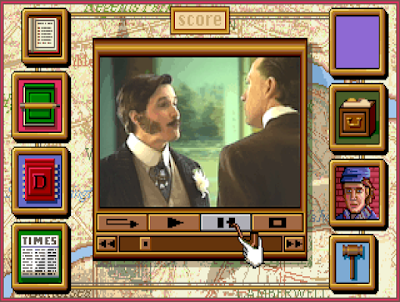 |
| These lambchop sideburns are awful. |
Dialog and Acting
As one of the few games of this era to offer real “dialog and acting” for me to score, this category should be fun. Overall the scripts and acting are good, but the combination of dialog errors and overly broad actors pulled it down a bit. The game is propped up by its selection of Holmes and Watson and they do wonders with what they have to work with. I found Holmes to see more tired and world-weary this time around, although that makes little sense narratively as the cases span his entire career. I’d love to learn more about the acting and staging of this game, but the actor that played Watson did not respond to my requests for an interview.
There were a handful of really “great” scenes– the two academics arguing at London University will remain one of my favorites– but the game is primarily held together by two talented actors that managed to make dry material better. They deserve a ton of credit for making this game successful. Kudos!
My score: 7
Final Tally
Let’s tally up those scores: (5+4+4+6+5+7)/.6 = 52! I’m not going to add or subtract any bonus points, so let’s just leave it right there.
When I started this game, I expected it to about equal its predecessor. In a lot of ways, it did with both improved lighting and the new judging videos. And yet, it also feels like a cheaper production overall with more use of obvious green screen and (at least to my memory) less dynamic and interesting locations. The cases were a mixed bag with more bugs than the previous game, but at least we didn’t have pseudo-science. The previous game scored 59 points and a drop of seven does seem a bit high, but I feel good about where it ended up.
With an average guess of 56, most of you thought this would do worse than the previous game but not this much worse. With an exact guess, Leo Velles is our winner! Congratulations on your new CAPs. I only hope you have caught up enough to read this post and see your fabulous winnings.
With that, I am signing off on “new” games for a while. I am undergoing extensive training so that I can thumb wrestle Will for a few Missed Classic spots. We have one more bonus post coming before Trinity (1986), plus I am currently playing our Christmas adventure. My next mainline game will be Space Quest V, seven games from now. I first volunteered here because I wanted to review Space Quest IV and finally getting around to the sequel feels nice.
CAP Distribution
200 CAPs to Will Moczarski
- Classic Blogger Award – 50 CAPs – for blogging through Curse of Crowley Manor
- Classic Blogger Award – 50 CAPs – for blogging through Escape from Traam
- Classic Blogger Award – 50 CAPs – for blogging through Earthquake – San Francisco 1906
- Classic Blogger Award – 50 CAPs – for blogging through Saigon: The Final Days
105 CAPs to Joe Pranevich
- Blogger Award – 100 CAPs – for blogging through Consulting Detective II for everyone’s enjoyment
- To the Manor Born Award – 5 CAPs – for discovering the weird coincidence of two ‘Manor’ games released in the same year
- Simba’s Pride Award – 5 CAPs – for the best possible solution to the Lions case (the lions themselves wanted out of the smuggling business)
- Send In The Clowns Award – 5 CAPs – for passing on some corsage wisdon
- Classic Prediction Award – 10 CAPs – for guessing equal closest to Curse of Crowley Manor
- Isn’t it Ironic Award – 5 CAPs – for pointing out the irony of the game mentioning a bug in the program, then having an actual bug in its own program that made the game unfinishable
- Classic Prediction Award – 10 CAPs – for getting the closest guess to Earthquake
34 CAPs to MorpheusKitami
- Part-time Companion Award – 9 CAPs – for playing along but giving up halfway through
- Moral Supporter Award 5 CAPs – for making me feel better about the second case
- CSI Award – 5 CAPs – for wondering why a coroner doesn’t know about exit wounds?
- Second Biggest I’ve Ever Seen Award – 5 CAPs – for letting us know about the obscure LaserActive
- Classic Prediction Award – 10 CAPs – for getting the closest guess to Escape from Traam, but still being off by 8 points!
- Unfasten and Unfurious Award – 20 CAPs – for succeeding in Will’s challenge to solve the first puzzle of Saigon
20 CAPs to Laukku
- Genre Support Award – 5 CAPs – for letting us know about the removal of some Sherlock Holmes games for sale
- Kickstarter Award – 5 CAPs – for mentioning the Summer Daze kickstarter before we did our official article on it.
- Classic Prediction Award – 10 CAPs – for getting the closest guess to Saigon
- Alerted an Author to Awesome Alliterative Alternatives Award – 5 CAPs – for appreciated advice after article appelation already actioned
- Classic Prediction Award – 10 CAPs – for guessing equal closest to Curse of Crowley Manor
11 CAPs to Lisa H
- Insight Award – 6 CAPs – for insightful commentary throughout
- Hello Boys Award – 5 CAPs – for knowing a lot about Aleister Crowley
10 CAPs to Ilmari Jauhiainen
- Help Granted Award – 10 CAPs – for helping with a request for assistance
10 CAPs to Vetinari
- As the Crowbar Flies Award – 10 CAPs – for correctly predicting the crowbar’s continued use in Earthquake
- Psychic Prediction Award – 10 CAPs – for guessing the final CAP rating
6 CAPs to Voltgloss
- Comparison Award – 6 CAPs – for looking up stuff in the tabletop version
5 CAPs to infidel
- Blue… No, Yellow Award – 5 CAPs – for teaching us about video production
5 CAPs to Reiko
- Proofreeding Award – 5 CAPs – for spotting many typos in the mulitple choice answers
- Funny Lions Award – 5 CAPs – for giving us more on Lenny Bruce
Original URL: https://advgamer.blogspot.com/2019/11/consulting-detective-vol-ii-hint-book.html

